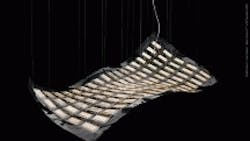Fluorescent white OLEDs hit 36 lm/W
Fluorescent white PIN OLEDs (organic light-emitting diodes) are billed as the world’s most power-efficient by their creator, Novaled AG in Germany. The new devices hit 36 lm/W thanks to use of proprietary organic materials and a new flat-light outcoupling method of extraction. Novaled says this is an 80% improvement in light emission over older devices.
Ordinary OLEDs typically can make use of only 25 to 35% of the light they generate. Novaled says its light extraction method improves on these figures. The new OLEDs also boost quantum efficiency in both bottom- and top-emission OLEDs. In bottom-emission OLEDs Novaled incorporates the material NET61 directly inside the electron transport layers. The combination of NET61 internal outcoupling and an external micro lens array (MLA) film boosts power efficiency by more than 70% and quantum efficiency by more than 80%.
In top-emission OLEDs, Novaled uses scattering material NLE17 on top of the semi-transparent top electrode to help extract light and improve the quality of light emitted from top-emission white OLED devices.
Unlike other outcoupling enhancement approaches in bottom-emission OLEDs – such as depositing complicated structured layers between substrate glass and the indium tin oxide (ITO) anode – Novaled uses simple internal outcoupling methods with vacuum evaporation processed organic materials to induce scattering of the light emitted by the OLED. In both bottom- and top-emission OLEDs, the scattering does not degrade electrical properties.
In addition, Novaled says its new method improves the Color Rendering Index (CRI) value for top-emission OLEDs on metal substrates. Top-emission samples on metal substrates with a white light emission typically have stronger cavity effects than bottom-emission devices and show strong variations with the viewing angle. Novaled uses a scattering evaporation processed organic layer on top of the semi-transparent top electrode which allows more light extraction from top-emission white OLEDs and strongly reduces angular color dependence. The company says its demonstrated CRI of 75 for top-emission OLEDs is ample for many commercial lighting applications.
More info: http://novaled.com/index.php
